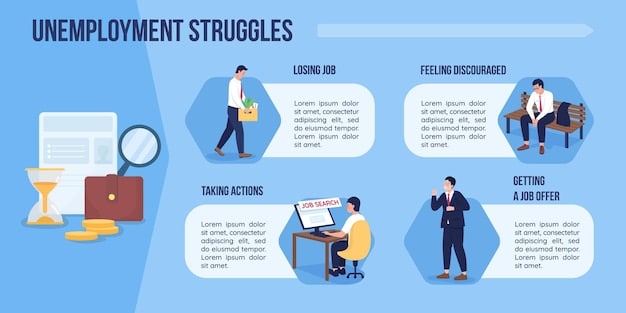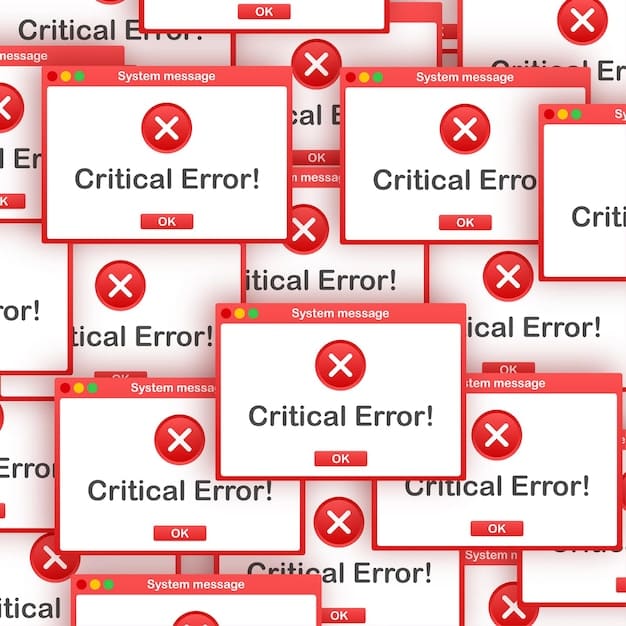Unemployment Benefits 2025: Eligibility & Claiming Guide

Anúncios
Understanding the Latest Updates to Unemployment Benefits: Eligibility and Claiming Strategies for 2025 involves navigating complex requirements and procedures to secure financial assistance during job loss, necessitating a comprehensive grasp of evolving regulations and effective claim filing methods.
Navigating the unemployment system can be daunting. Let’s break down understanding the latest updates to unemployment benefits: eligibility and claiming strategies for 2025 so you can successfully file your claim and receive the support you need when you need it most.
Anúncios
Understanding Updated Eligibility Criteria for 2025
To successfully claim unemployment benefits, understanding eligibility criteria is paramount. These requirements often evolve, reflecting economic conditions and legislative adjustments. For 2025, several key updates are expected, affecting who can qualify and how to navigate the application process.
Work History Requirements
A primary factor in determining eligibility is your past work history. This involves assessing the length of time you were employed and the amount you earned during a specific base period. States typically use the first four of the last five completed calendar quarters as the base period.
Anúncios
- Minimum Earnings: Most states require a minimum amount of earnings during the base period to qualify for benefits. This ensures that claimants have a significant work history.
- Qualifying Wages: Claimants must have earned wages in at least two quarters of the base period in many states.
- Sufficient Work Duration: Some states require a minimum number of work hours or weeks worked during the base period.
Reasons for Unemployment
The reason for your unemployment is another critical factor. Generally, you must be unemployed through no fault of your own. This typically includes layoffs, company downsizing, or job elimination.
- Layoffs: If you were laid off due to company restructuring, lack of work, or budget cuts, you are generally eligible for unemployment benefits.
- Discharge: Being fired for misconduct can disqualify you. States review each case individually, and eligibility depends on the severity and nature of the misconduct.
- Voluntary Quit: Quitting your job voluntarily usually disqualifies you unless it was for a compelling reason, such as unsafe working conditions or a significant change in job duties.
Availability and Active Job Search
To maintain eligibility, you must be available to work and actively seeking employment. This means you must be ready and willing to accept suitable job offers. An active job search usually involves registering with the state’s employment agency, submitting applications, and attending interviews.
- Suitable Work: States define what constitutes suitable work, considering factors like your skills, experience, and prior earnings.
- Job Search Activities: Consistent job search activities are essential. Document these activities, including dates, employer contacts, and application details, as states often require proof of your efforts.
- Work Availability: You must be able to work full-time and be available for any suitable job offers. Restrictions on your availability can impact your eligibility.
Understanding the updated eligibility criteria for 2025 is crucial for a successful claim. Meeting these requirements ensures that you can access the financial support needed while you seek new employment.

Navigating the Application Process Step-by-Step
The unemployment application process can seem complex, but breaking it down into manageable steps can simplify the experience. Understanding each stage, from initial application to ongoing requirements, is crucial for a successful claim.
Gathering Necessary Documents
Before starting your application, gather all necessary documents. This will streamline the process and avoid delays. Essential documents typically include:
- Social Security Number: Your Social Security number is required for identification purposes.
- Employment History: Provide detailed employment history for the past 18 months, including employer names, addresses, dates of employment, and reasons for separation.
- Wage Information: Have your W-2 forms or pay stubs available to verify your earnings.
Completing the Initial Application
Most states allow you to file your unemployment claim online. The application will require detailed information about your work history, reasons for unemployment, and contact information.
- Online Application: Filing online is generally the fastest and most efficient way to apply. Be prepared to spend some time completing the application accurately.
- Accuracy: Ensure all information provided is accurate and truthful. Errors or omissions can delay or disqualify your claim.
- Confirmation: After submitting your application, you will receive a confirmation notice. Keep this for your records.
Attending Interviews and Providing Additional Information
In some cases, you may be required to attend an interview with a state unemployment representative. This is often to clarify details in your application or to address any potential issues.
Following these steps carefully will help ensure a smooth and successful application process. Being prepared and organized can make a significant difference in the outcome of your claim.
Maximizing Your Benefit Amount: Strategies and Tips
Unemployment benefits are designed to provide temporary financial assistance, and understanding how to maximize your benefit amount can significantly ease financial stress during unemployment. Several strategies and tips can help you optimize your claim.
Understanding Benefit Calculation
Each state has its own method for calculating unemployment benefits, typically based on a percentage of your past earnings. Understanding this calculation can help you estimate your potential benefits.
Maximizing your benefit amount requires a thorough understanding of state regulations and strategic planning. By following these tips, you can ensure you receive the maximum support available.
Common Mistakes to Avoid When Claiming Benefits
Navigating the unemployment system can be complex, and making mistakes can lead to delays, reduced benefits, or even disqualification. Avoiding common pitfalls is essential for a smooth and successful claim process.
Inaccurate or Incomplete Information
Providing accurate and complete information on your application is crucial. Inaccuracies can raise red flags and trigger further investigation.
Failure to Meet Job Search Requirements
Most states require you to actively seek employment to maintain eligibility for unemployment benefits. Failing to meet these requirements can result in a loss of benefits.
- Documenting Efforts: Keep a detailed record of all your job search activities, including dates, employer contacts, and application details.
- Meeting Minimum Requirements: Be sure to meet the minimum number of job contacts required by your state each week.
- Suitable Work: Apply for suitable work that aligns with your skills and experience.
Not Responding to State Communications
States often communicate with claimants via mail, email, or phone. Ignoring these communications can lead to misunderstandings and potential issues.
- Check Regularly: Regularly check your mail, email, and phone for any communications from the state unemployment agency.
- Respond Promptly: Respond to any requests for information or interviews promptly.
- Keep Contact Information Updated: Ensure the state has your current contact information to avoid missing important notices.
Avoiding these common mistakes can significantly improve your chances of a successful unemployment claim. Being proactive, accurate, and responsive will help you navigate the process effectively.

How to Handle Denied Claims and Appeals
Receiving a denial for your unemployment claim can be disheartening, but it is not necessarily the end of the road. Understanding the appeals process and how to effectively present your case can help you overturn a denial and receive the benefits you are entitled to.
Understanding the Reason for Denial
The first step in handling a denied claim is to understand why it was denied. The denial notice should provide a detailed explanation of the reasons for the decision.
Gathering Evidence and Documentation
To support your appeal, gather all relevant evidence and documentation. This may include:
- Employment Records: Pay stubs, W-2 forms, and employment contracts can help verify your work history and earnings.
- Termination Documentation: Any documentation related to your termination, such as layoff notices or performance reviews, can be crucial.
- Witness Statements: Statements from coworkers or supervisors can provide additional support for your case.
Filing an Appeal
Once you understand the reason for denial and have gathered your supporting evidence, the next step is to file an appeal. Most states have specific procedures and deadlines for filing appeals.
- Meeting Deadlines: Be sure to file your appeal within the specified deadline, as late appeals may not be accepted.
- Following Procedures: Follow the state’s prescribed appeal procedures carefully. This may involve submitting a written appeal form or attending a hearing.
- Presenting Your Case: In your appeal, clearly and concisely explain why you believe the denial was incorrect. Present your evidence and supporting documentation in an organized manner.
Handling a denied claim and navigating the appeals process requires a thorough understanding of your rights and responsibilities. By understanding the reasons for denial, gathering supporting evidence, and effectively presenting your case, you can increase your chances of a successful appeal.
Preparing for 2025: Future Trends and Potential Changes
The landscape of unemployment benefits is constantly evolving, influenced by economic conditions, legislative changes, and technological advancements. Preparing for potential changes and future trends can help you stay informed and better navigate the system.
Legislative Updates and Policy Changes
Legislative updates and policy changes can significantly impact unemployment benefits. Staying informed about these changes is crucial for both claimants and employers.
- Tracking Legislation: Monitor federal and state legislation related to unemployment benefits. This can provide insights into potential changes and their implications.
- Understanding New Regulations: Familiarize yourself with any new regulations or guidelines issued by state unemployment agencies.
Technological Advancements
Technology is playing an increasingly important role in the administration of unemployment benefits. Automation, online portals, and data analytics are transforming the way claims are processed and managed.
- Online Portals: Utilize online portals for filing claims, submitting documents, and tracking your benefit status. These portals streamline the process and provide convenient access to information.
- Data Analytics: Understand how data analytics are used to detect fraud and ensure compliance. Be prepared to provide accurate and truthful information to avoid raising red flags.
Economic Factors
Economic factors, such as unemployment rates, inflation, and industry trends, can influence the availability and duration of unemployment benefits. Monitoring these factors can help you anticipate potential changes and plan accordingly.
- Unemployment Rates: Keep an eye on unemployment rates in your state and industry. High unemployment rates may lead to extensions of benefit periods or additional support programs.
- Industry Trends: Consider industry trends and their impact on job security. If you work in a declining industry, be proactive in seeking retraining or new career opportunities.
Preparing for future trends and potential changes in the unemployment benefits system requires ongoing vigilance and adaptability. By staying informed, leveraging technology, and monitoring economic factors, you can navigate the system effectively and secure the support you need.
| Key Point | Brief Description |
|---|---|
| 📝 Eligibility Criteria | Meeting work history, reason for unemployment, and availability requirements. |
| 💼 Application Process | Gathering documents, completing the application accurately, and attending interviews if needed. |
| 💰 Maximizing Benefits | Understanding the calculation, reporting all income accurately, and exploring extensions. |
| 🛑 Avoiding Mistakes | Providing accurate data, meeting job search requirements, and responding to state communications promptly. |
Frequently Asked Questions
▼
To be eligible, you generally need to have sufficient work history, be unemployed through no fault of your own, and be available and actively seeking work. Specific requirements vary by state.
▼
The weekly benefit amount is typically calculated as a percentage of your earnings during a base period, which is usually the first four of the last five completed calendar quarters.
▼
If your claim is denied, review the denial notice to understand the reason, gather supporting documentation, and file an appeal within the specified deadline.
▼
Most states require you to report your job search activities weekly or bi-weekly. Keep detailed records of your efforts and report them accurately to maintain eligibility.
▼
In some cases, you may be eligible for benefits if you quit your job for compelling reasons, such as unsafe working conditions or a significant change in job duties.
Conclusion
Understanding the latest updates to unemployment benefits, eligibility, and claiming strategies for 2025 is crucial for those facing job loss. By staying informed and following best practices, you can navigate the system effectively and secure the financial support you need during challenging times.





